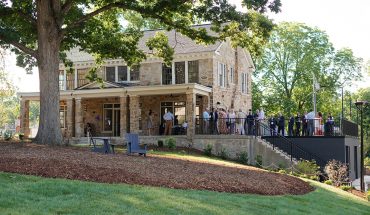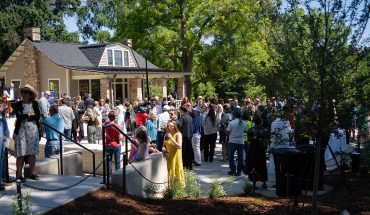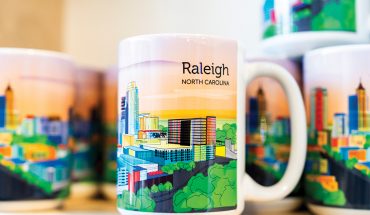Dix Park launches its master plan for the future
By Catherine Currin | Photography by Joshua Steadman

“We are in the treasure hunt phase,” Dix Park planning supervisor Kate Pearce told WALTER in late 2017. Over a year later, the sentiment is the same, but the description is a bit different. “We’re in this unique period of transformation,” she says. “Now it’s all about how we move from vision to reality., and we’re building momentum and support to push there. That will determine how this place transforms over the next 5, 10, 15 years.” The sprawling 309.7-acre plot is a relaxing refuge in the midst of downtown Raleigh, and the vision includes a creek, meadows, gardens, and designated areas for sport and recreation. “The fact that our city leadership has preserved hundreds of acres for future generations is pretty amazing,” Pearce says. The city is at an advantage with a piece of land that already looks and feels like a park in many ways—trees, a vast green, and a creek. “There’s a uniqueness about Dix,” she says. “In its size, location in the heart of a city, and in its beauty.”
The park released its final master plan at the end of 2018. It includes a vision for every acre of the park, which was acquired by the City of Raleigh in 2015. In layman’s terms, Pearce says the master plan is essentially both a vision for the future of the park, and a roadmap of how to get there. In it, there are maps filled with large concepts, and specific recommendations to achieve that concept. The plan consists of four chapters: the land (maps, renderings, landscapes), the framework (gateways, entrances, etc), the program (what will happen at the park), and the implementation (the roadmap). The land and framework will endure, while the program will continue to evolve over time.
According to Pearce, a park never stops growing. Take Central Park, for example. “Central Park was built in the 1850 with no playgrounds. As New York City identified itself, playgrounds were added in. It’s one example of a great urban park—there are fundamental elements, but it responds to changing community needs.”
This year, Raleighites will start to see some small changes at the park that are roadmapped in the master plan. Restrooms, walking trails, and benches are a few additions that will take shape. Honoring the space’s history is also in the works, too. Dorothea Dix was a champion for the mentally ill, and her hospital was home to patients for almost 200 years. This context is not lost on the city, the Dix Park Conservancy, or the Advisory Committee. “Our goal is to honor and recognize the history,” says Pearce. “How do we transform from a mental health hospital to a park that continues to respect the lives impacted during that time?”

It takes a village
Between the City of Raleigh, the Dix Park Conservancy, and other committees, there’s hardly a resource that Dix Park planning hasn’t tapped into. In fact, it’s the community engagement in this initiative that is truly remarkable.
Typically, a park in development will recruit a neighborhood committee. For Dix, the scale and impact reaches countless neighborhoods, so a Master Plan Advisory Committee (MPAC) had to be formed. “There’s a community-wide impact,” Pearce says, “and we wanted to drive input from all areas of the community.” The 44 members of the committee come from diverse backgrounds and reside across Raleigh and beyond. While each member has his or her own interests and reasons for getting involved, an awareness of the park’s huge potential impact is evident across the board. “They’re an amazing group of people with different experiences,” says Pearce. “They really push the design team to think about community.”
As a runner, MPAC member and Runologie co-founder Brent Francese says he can’t wait for the Promenade Loop, and he hopes the park will become a go-to green space for his family. “It’ll attract the community as a gathering space, be a space of reflection, and it will attract top talent from around the state and beyond. The park will be an amenity that many other cities will want to have.” At the forefront of the committee’s conversation is the messaging that those involved with the planning will pass on to the community at large. An advisor on the project and CEO of Neighborland, Dan Parham feels strongly that the park doesn’t have just one key element that makes it fantastic. “There isn’t just one thing. The Promenade Loop will be as large as New York’s High Line; the lawn is as big as Prospect Park in Brooklyn. There isn’t one signature item of Dix, there’s a multitude.”
Parham has worked on numerous planning projects in his professional life, and he says he hoped to collaborate and share his knowledge. “As a resident of downtown Raleigh, I’m invested in the future of our city. Given the potential of Dix Park to profoundly impact the future of the city and region, I felt compelled to join the advisory committee to help the project succeed. This project is unparalleled in terms of park planning right now, so it’s an honor to be a part of it.”
This committee has played a crucial role in the master plan of the park, but they still are only one piece of the puzzle. There’s also the executive committee and the conservancy, the latter raising over $9 million to date. It’s a rare advantage to already have a conservancy in the planning stages of a park. The conservancy will continue as advocates for the park, working to make it a space that is apolitical over time, says Pearce. “We hope this is something that future city council members and other leaders will continue to support without hesitation.”

Something for everyone
“A park is the most civic and democratic space in the community. It’s free and open to public,” Pearce says. “Parks at their very essence are egalitarian. You may not have money to go to the beach or the mountains, but you can go to Dix Park. It’ll be free, and it will be a vacation in the city.” What’s so amazing about Dix is the fact that it does not discriminate. All are welcome, whether you are someone in your 20s playing pick-up soccer or a parent bringing your kids to the sunflower fields. “Ultimately, the park will be a game changer for our community and state—it will be utilized on a daily basis by local residents, and as a destination to those outside the immediate area,” says MPAC member Edward Vinson. The day-to-day impact will add to Raleigh’s edge—an edge that continues to set the City of Oaks on a trajectory to become a major hub for technology, business, and a high standard of living.
The ‘land’ portion of the master plan consists of six unique breakouts: The Creek, which exists along S. Saunders Street, will be exposed as the park’s water source; The Meadow, an extension of the current ‘big field,’ will include playgrounds, the historic cemetery, and gardens; The Grove will begin at the park entrance and become a garden for picnicking and gathering; The Downtown Gateway will merge downtown Raleigh with bus drop-offs, an entry plaza, and repurposed historic buildings; The Ridge will preserve pieces of the Dix Hill campus for new uses such as event spaces and sports courts; and The Valley will include a grotto garden, performance spaces, and a dog park.
“There’s going to be something for everyone to love! The long meadow will be a beautiful respite in the city, and if we can get a land bridge to extend it even further, all the better,” says MPAC member Ashton Smith. “There’s a great opportunity with the State Farmers Market, N.C. State, and the surrounding neighborhoods. I’m also excited to see how we are able to remember and honor the entire history of the site.”
With the help of the landscape architects of Michael Van Valkenburgh Associates, those involved with the park hope to lay the foundation for a smooth transition from hospital to park. Each decision is intentional, and the City Council will take a final vote on the plan at its meeting February 19. Yet a simple vote encompasses more than the council it stands before, Pearce says. “The development of this park will span over numerous mayors, councils, and planners. At this moment, we can cement the future. This council has such a great responsibility to put this vision into place.”




